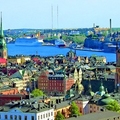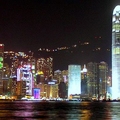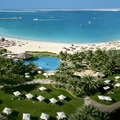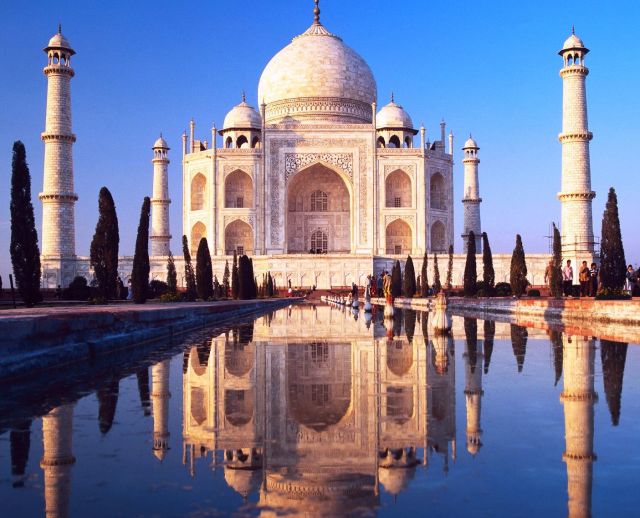Destinations / The best capital cities in the world / New Delhi
New Delhi
Description
New Delhi is not only the capital of India, but in conjunction with the old district of Delhi it is one of the largest cities in the world with a wide variety of attractions. The city is rich in temples of different religion. The temples are located very close to each other, creating sometimes a unique contrast. This city is compared to the mausoleum, due to the large number of memorials. The city hosts a variety of gardens and parks facilities. The most famous gardens are: Mughal, Shalimarskie and Roshanarskie. Delhi is one of the richest cities in the country, having the best transport and infrastructure all over India. Commercial and shopping malls, mass media, the automotive industry developed quite rapidly here. It is not only a city in India, it is a city with different cultures and nationalities.
History of New Delhi
One of the oldest cities in the world, Delhi was the capital of mighty empires and small sultanates, it was the witness of many rise and fall dynasties. The tall minarets, palaces, majestic temples, splendid mausoleums and impregnable forts always impressed and surprised the visitors. The wealth and splendor are like a magnet for seekers of treasures and adventures from over the world. The city was completely destroyed for several times, but as a phoenix, it rose again from the ashes more beautiful than before. Among the researchers of Delhi history there is no one consensus as to how many settlements existed on the territory of what is now the Indian capital. Calcutta was the capital of British India since 1577. But Delhi served as the political and financial center of several empires of ancient and medieval India, in particular the Mughal Empire. The British administration was proposed to move the capital of the Indian Empire from Calcutta to Delhi in the early 1900s. Unlike Calcutta, located on the east coast of India, New Delhi is located in the northern India, and the government of British India felt that it will be easier to rule the country from Delhi. George V laid the foundation stone of the new capital of British India - New Delhi in late 1911. The work began in 1912, and during the First World War had been suspended. The main building was finished only in 1928. The formal opening ceremony was held in New Delhi on February 10, 1931.
Extraordinary Attractions
Humayun's Tomb
Humayun's Tomb is a large mausoleum complex. The tomb was built of white marble and red sandstone and was the prototype of the Taj Mahal Agra. The building is a great copy of Mughal architecture. The tomb was built in the middle of the XVI century. It is surrounded by a garden, which houses the tomb of the barber Humayun and Isa Khan, the architect of the Taj Mahal.
India Gate
India Gate is a stone arch built as a memorial to commemorate the Indian soldiers who died in the First World War. An eternal flame is lighted at the foot of it. More than 90,000 names are cut on the arch. India Gate stands on a red stone foundation and on the top of it is a hollow bowl, where fuel oil had to be poured, in order to keep the flame from the top of the arch during the war anniversary, but it has not been done. The area around the arch is always lively, children play here, adults meet to talk, and street vendors jostle. This is the perfect holiday destination in summer and the best choice for a picnic in the winter. The arch is illuminated by searchlights, and the nearby fountains are illuminated by colored lights at night.
Connaught Place
Connaught Place represents a broad ring in the center of New Delhi. It is a business, entertainment and shopping center. This area was created by the British and named in the honor of the Duke who visited India. The ring is surrounded by green areas, from which seven roads begin.
Qutub Minar
The Qutub Minar building was initiated in the XII century and finished in the XIII century. This ornamental tower attracts many tourists who want to climb it and view the city from its heights. The tower rises to a height of 230 feet, has 5 levels and is decorated with intricate ornamentation. The first three floors are made of red sandstone, the fourth and the fifth floors are made of sandstone and white marble. The ornament reflects the Qutub Minar history and contains extracts from the Koran. The complex surrounding of the Qutub Minar includes the mosque Kuwata-ul-Islam Masjid, situated at the foot of the tower, Altamisha, Alaudin Khaldzhi and Imam Zamin tombs and a 200 years old iron pillar under the name of Alai Minar. The complex has experienced a lightning strike, several earthquakes, but despite all these the building is well.
International Toilet Museum
The International Toilet Museum represents the evolution of toilets and their various designs. The most ancient objects related to a toilet, which are displayed in the museum date back to 2500 BC. The facts, artifacts and photographs tell in chronological order the story of toilet etiquette and sanitation technology.
Indira Gandhi Memorial Museum
The Indira Gandhi Memorial Museum is located in the former residence of Indira Gandhi. The exhibition includes photographs of Indira since her childhood till the post of the prime minister, her personal belongings, saris, which she wore on the day of the murder, personal correspondence. The museum building is surrounded by flowering gardens. Indira Gandhi ruled India for almost 20 years until her Sikh bodyguard killed her in 1984 while walking in the garden. The path, along which she walked that day, is considered now part of the memorial. The place where Indira Gandhi fell is noted with transparent glass. Several rooms of the museum are devoted to the life of her son Rajiv Gandhi, assassinated in 1991. The library and the lounge are stored in the form in which she left it, the public is not allowed here, but you can look at the interior through the garden windows.
Nehru Memorial Museum and Planetarium
The building was once the residence of India's first prime minister and was known as Teen Murti Bhavan. Photographs and newspaper clippings tell the story of the independence movement. The exhibition is about Nehru life and work, the exhibits related to the struggle for independence being particularly interesting. A large collection of photographs can be found in the bedroom and in the living room. The planetarium is located at the basement of the museum. You’ll find out about the Indian space program here.
Mosque Jama Masjid
The Mosque Jama Masjid is one of the largest mosques in India and one of the final Shah Cihan buildings. The construction of the mosque began in 1644 and it was completed in 1658. The mosque has three arched entrances, four corner towers and two 40th meters minarets. The building was built of white marble and red sandstone, laid in vertical stripes. Visitors can climb to the southern minaret to see the old town from its height. There is a swimming pool to wash hands, the face and the feet in the center of the mosque courtyard. Visitors must remove their shoes and make sure they are dressed appropriately before entering the mosque. Non-Muslims are not allowed to pass on the territory during the prayers.
Crafts Museum
The museum contains numerous handcrafts from all over India. However, tourists are attracted by the artisans that come here to demonstrate their skills. Among the exhibits you can see textiles, ceramics, and wooden products. There is a model of village with traditional mud huts and a model of wooden shacks of the life-size from Gujarat, decorated with carvings, paintings and embroidery.
National ZoologicalPark
National Zoological Park in New Delhi is one of the best zoos in Asia. The park was opened in 1959 and it is home for 2,500 animals and birds now. The wildlife all over the world: Africa, America, Australia and Asia is presented here. You can see the chimps, hippos, spider monkeys, zebras, monkeys, hyenas, deer, jaguars in the park. Underground Reptile Centre will give you the opportunity to observe the different snakes.
National Museum
The gallery of the National Museum reflects the course of the Indian history and its most important events, from the Mauryan Empire. The archaeological finds made at Mohenjo-daro, Harappa, Lotale, Kalibangane are displayed in the museum. The collection of the museum consists of terracotta figurines, pottery, jewelry, seals, copper and bronze tools, sculpture, musical instruments, tribal masks and swords, fragments of frescoes. It is considered one of the best exhibitions devoted to Central Asia, silk banners, sculptures, objects, collected by Sir Aurel Stein between 1900 and 1916, elements of life, through which ran the Silk Road are exhibited here.
Jantar Mantar Observatory
Jantar Mantar Observatory is one of the five observatories built by Maharaja Jai Singh I in 1725. Its form is dominated by a huge sundial known as the "king of dials". You can observe the motion of the sun,of the moon and of the planets in the observatory. The antique tools which helped to see the heavenly bodies track and predict eclipses are exhibited here.
Rajput
Rajput, also known as "the way of kings" is a boulevard in New Delhi. It begins at the Rashtrapati Bhavan, passing through Vijay Chowk and the gates of India's National Stadium. Trees and flowers are planted on both sides of the boulevard. A parade is held here, every year on January 26 at the Republic Day. Thousands of people come here to see it. The Rashtrapati Bhavan, the palace of the president is located at the west end of Rajpath. It was the residence of the royal regent before India gained independence. This is one of the most beautiful buildings in New Delhi, combining the architectural styles of Europe and the Mughal style. The Mongolian gardens are situated at the west of the palace. These gardens are opened to visitors on certain days since mid-February to early March.
Red Fort
The Red Fort building was initiated in 1638 by Shah Dzhihanom and was completed in 1648. This building was the residence of the rulers of the Mughal since 1639 to 1857. The height of the red sandstone walls ranges from 18 to 33 meters. The fort is made in the shape of a cross and it is surrounded by a moat. The Gates of Lahore is the main entrance to the fort. Delhi Gate is a larger and more luxurious way. Once every Friday, the emperor used it to take part in ceremonial processions, moving to the Jama Masjid Mosque. Going through the Gates of Lahore, visitors enter an indoor market Chatta Chowk. This is one of the first indoor markets, opened in the XVII century. Silks, jewelry, semiprecious stones and silver works of art were sold here. Mostly souvenirs are sold here now. Nubat Khan is located on the territory of the fort. The musicians who played for the emperor each day lived there. Large musical instruments such as cymbals, timpani and oboes are kept here now. The rooms for private and public audiences: Diwan-i-Am, Diwan-i-Khas are also located on the fort area.
Tibet House
A collection of ceremonial Dalai Lama accessories can be found in the Tibet House. The accessories were brought by Dalai Lama during his escape from the country during the Chinese aggression. Being the cultural center of the Tibetan and Buddhist teachings, Tibet House tries to preserve its unique heritage. The exhibition presents wooden sculptures, paintings, carpets and ritual objects to you. Some of them were brought from the Tibetan monasteries, others from the villages, scattered throughout India. The library and museum located here houses a variety of ancient art from Tibet, with more than 200 statues of bronze, copper, brass and sandalwood, and many religious artifacts, etc.
House Khas
House Khas is a small town in the south of New Delhi. Ancient stone monuments are located on both sides of the road in the House Khas. A lot of graves of the royal family XIV - XVI centuries can be found in the countryside. The ruins of the ancient college and Firoz Shah tomb, who ruled Delhi in the XIV century, are here. The Moth Ki Masjid, a beautiful mosque built in the style of Lodi is located in the east of the village. House Khas was one of the main attractions in 1980, and besides ancient ruins, there are art galleries, trendy restaurants and boutiques in the House Khas.
Lotus Temple
The Lotus Temple is named so for its unusual design, reminiscent of a lotus flower. This temple is one of newest Bahai Temple. The building of the temple was created out of white concrete and white Greek marble. The temple overlooks a green park, in which there are 9 swimming pools. There no idols or religious images and some symbols related to religion inside the temple. There are services every day here, at other times, it's a quiet place of worship.
Chandni Chowk
Chadni Chowk is the main fare of old Delhi and the shopping center. This is a huge space just stuffed with shops, markets, and crowds of people. You can find everything your heart desires on the largest wholesale market of Asia. You will find hundreds of different kinds of spices as anise, cinnamon, saffron, lotus seeds in the spices markets Naya Bazaar and Market Gadodial.
New Delhi is the capital with a wide variety of attractions that should be visited at least once by you.
Others The best capital cities in the world .
Others from The best capital cities in the world
Who doesn't wish for an exciting vacation or who isn't attracted by fascinating experiences? This poll provides comprehensive information about the best, most important capital cities in the world that we generally recommend as wonderful places to explore.
Let them be your starting point and consider these places might occur to you and suit your goals.
These are the most liveable,friendly and multicultural cities on Earth, with the most exciting cultures,with the most beautiful beaches, with the most lively nightlife and the most beautiful scenery.
Explore the cities and find out the best kept secret of each of them.
I'm sure you'll experience senses to the fullest intensity.


















